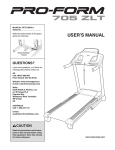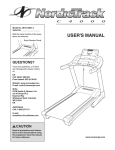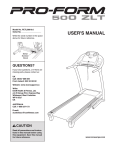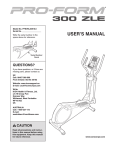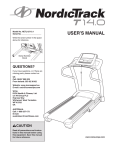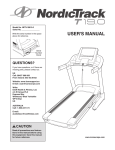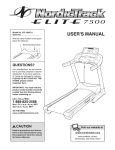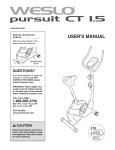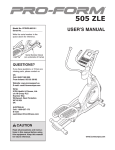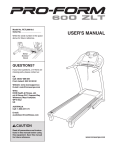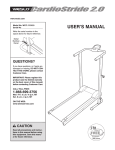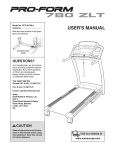Download ProForm 905 Zlt Treadmill User`s manual
Transcript
Model No. PETL11810.0 Serial No. Write the serial number in the space above for reference. USER'S MANUAL Serial Number Decal QUESTIONS? If you have questions, or if there are missing parts, please contact us: UK Call: 08457 089 009 From Ireland: 053 92 36102 Website: www.iconsupport.eu E-mail: [email protected] Write: ICON Health & Fitness, Ltd. c/o HI Group PLC Express Way Whitwood, West Yorkshire WF10 5QJ UK AUSTRALIA Call: 1-800-237-173 E-mail: [email protected] CAUTION Read all precautions and instructions in this manual before using this equipment. Save this manual for future reference. www.iconeurope.com TABLE OF CONTENTS WARNING DECAL PLACEMENT . . . . . . . . . . . . . . . . . . . . . . . . . . . . . . . . . . . . . . . . . . . . . . . . . . . . . . . . . . . . . .2 IMPORTANT PRECAUTIONS . . . . . . . . . . . . . . . . . . . . . . . . . . . . . . . . . . . . . . . . . . . . . . . . . . . . . . . . . . . . . . . .3 BEFORE YOU BEGIN . . . . . . . . . . . . . . . . . . . . . . . . . . . . . . . . . . . . . . . . . . . . . . . . . . . . . . . . . . . . . . . . . . . . . .5 ASSEMBLY . . . . . . . . . . . . . . . . . . . . . . . . . . . . . . . . . . . . . . . . . . . . . . . . . . . . . . . . . . . . . . . . . . . . . . . . . . . . . . .6 HOW TO USE THE CHEST PULSE SENSOR . . . . . . . . . . . . . . . . . . . . . . . . . . . . . . . . . . . . . . . . . . . . . . . . . . .15 OPERATION AND ADJUSTMENT . . . . . . . . . . . . . . . . . . . . . . . . . . . . . . . . . . . . . . . . . . . . . . . . . . . . . . . . . . . .16 HOW TO FOLD AND MOVE THE TREADMILL . . . . . . . . . . . . . . . . . . . . . . . . . . . . . . . . . . . . . . . . . . . . . . . . . .23 TROUBLESHOOTING . . . . . . . . . . . . . . . . . . . . . . . . . . . . . . . . . . . . . . . . . . . . . . . . . . . . . . . . . . . . . . . . . . . . .25 EXERCISE GUIDELINES . . . . . . . . . . . . . . . . . . . . . . . . . . . . . . . . . . . . . . . . . . . . . . . . . . . . . . . . . . . . . . . . . . .28 PART LIST . . . . . . . . . . . . . . . . . . . . . . . . . . . . . . . . . . . . . . . . . . . . . . . . . . . . . . . . . . . . . . . . . . . . . . . . . . . . . .30 EXPLODED DRAWING . . . . . . . . . . . . . . . . . . . . . . . . . . . . . . . . . . . . . . . . . . . . . . . . . . . . . . . . . . . . . . . . . . . .32 ORDERING REPLACEMENT PARTS . . . . . . . . . . . . . . . . . . . . . . . . . . . . . . . . . . . . . . . . . . . . . . . . . .Back Cover RECYCLING INFORMATION . . . . . . . . . . . . . . . . . . . . . . . . . . . . . . . . . . . . . . . . . . . . . . . . . . . . . . . . .Back Cover WARNING DECAL PLACEMENT This drawing shows the locations of the warning decals. If a decal is missing or illegible, call the telephone number on the front cover of this manual and request a free replacement decal. Apply the decal in the location shown. Note: The decals may not be shown at actual size. PROFORM is a registered trademark of ICON IP, Inc. 2 IMPORTANT PRECAUTIONS WARNING: To reduce the risk of serious injury, read all important precautions and instructions in this manual and all warnings on your treadmill before using your treadmill. ICON assumes no responsibility for personal injury or property damage sustained by or through the use of this product. 1. Before beginning any exercise program, consult your physician. This is especially important for persons over age 35 or persons with pre-existing health problems. 11. When connecting the power cord (see page 16), plug the power cord into an earthed circuit. No other appliance should be on the same circuit. When replacing the fuse in the power cord adapter, insert an ASTA-approved BS1362, 13-amp fuse into the fuse carrier. 2. It is the responsibility of the owner to ensure that all users of this treadmill are adequately informed of all warnings and precautions. 12. If an extension cord is needed, use only a 3conductor, 14-gauge (1 mm2) cord that is no longer than 5 ft. (1.5 m). 3. Use the treadmill only as described. 4. Place the treadmill on a level surface, with at least 8 ft. (2.4 m) of clearance behind it and 2 ft. (0.6 m) on each side. Do not place the treadmill on any surface that blocks air openings. To protect the floor or carpet from damage, place a mat under the treadmill. 13. Keep the power cord away from heated surfaces. 14. Never move the walking belt while the power is turned off. Do not operate the treadmill if the power cord or plug is damaged, or if the treadmill is not working properly. (See TROUBLESHOOTING on page 25 if the treadmill is not working properly.) 5. Keep the treadmill indoors, away from moisture and dust. Do not put the treadmill in a garage or covered patio, or near water. 15. Read, understand, and test the emergency stop procedure before using the treadmill (see HOW TO TURN ON THE POWER on page 18). 6. Do not operate the treadmill where aerosol products are used or where oxygen is being administered. 16. Never start the treadmill while you are standing on the walking belt. Always hold the handrails while using the treadmill. 7. Keep children under age 12 and pets away from the treadmill at all times. 8. The treadmill should be used only by persons weighing 330 lbs. (150 kg) or less. 17. The treadmill is capable of high speeds. Adjust the speed in small increments to avoid sudden jumps in speed. 9. Never allow more than one person on the treadmill at a time. 18. The pulse sensor is not a medical device. Various factors, including the user's movement, may affect the accuracy of heart rate readings. The pulse sensor is intended only as an exercise aid in determining heart rate trends in general. 10. Wear appropriate exercise clothes when using the treadmill. Do not wear loose clothes that could become caught in the treadmill. Athletic support clothes are recommended for both men and women. Always wear athletic shoes. Never use the treadmill with bare feet, wearing only stockings, or in sandals. 3 23. Inspect and properly tighten all parts of the treadmill regularly. 19. Never leave the treadmill unattended while it is running. Always remove the key, unplug the power cord, and press the power switch into the off position when the treadmill is not in use. (See the drawing on page 5 for the location of the power switch.) 24. 20. Do not attempt to raise, lower, or move the treadmill until it is properly assembled. (See ASSEMBLY on page 6, and HOW TO FOLD AND MOVE THE TREADMILL on page 23.) You must be able to safely lift 45 lbs. (20 kg) to raise, lower, or move the treadmill. DANGER: Always unplug the power cord immediately after use, before cleaning the treadmill, and before performing the maintenance and adjustment procedures described in this manual. Never remove the motor hood unless instructed to do so by an authorized service representative. Servicing other than the procedures in this manual should be performed by an authorized service representative only. 25. This treadmill is intended for in-home use only. Do not use this treadmill in a commercial, rental, or institutional setting. 21. When folding or moving the treadmill, make sure that the storage latch is holding the frame securely in the storage position. 26. Over exercising may result in serious injury or death. If you feel faint or if you experience pain while exercising, stop immediately and cool down. 22. Never insert any object into any opening on the treadmill. SAVE THESE INSTRUCTIONS 4 BEFORE YOU BEGIN Thank you for selecting the revolutionary PROFORM® 905 ZLT treadmill. The 905 ZLT treadmill offers an impressive array of features designed to make your workouts at home more enjoyable and effective. And when youʼre not exercising, the unique treadmill can be folded up, requiring less than half the floor space of other treadmills. ing this manual, please see the front cover of this manual. To help us assist you, note the product model number and serial number before contacting us. The model number and the location of the serial number decal are shown on the front cover of this manual. Before reading further, please familiarize yourself with the parts that are labeled in the drawing below. For your benefit, read this manual carefully before using the treadmill. If you have questions after read- Console Accessory Tray Pulse Sensor Handrail Upright Key/Clip Power Switch Walking Belt Foot Rail Platform Cushion Idler Roller Adjustment Bolts 5 ASSEMBLY Assembly requires two persons. Set the treadmill in a cleared area and remove all packing materials. Do not dispose of the packing materials until assembly is completed. Note: The underside of the treadmill walking belt is coated with high-performance lubricant. During shipping, some lubricant may be transferred to the top of the walking belt or the shipping carton. This is normal and does not affect treadmill performance. If there is lubricant on top of the walking belt, simply wipe off the lubricant with a soft cloth and a mild, non-abrasive cleaner. Assembly requires the included hex key and your own Phillips screwdriver adjustable wrench , needlenose pliers , and scissors , . Use the drawings below to identify the assembly hardware. The number in parentheses below each drawing is the key number of the part, from the PART LIST near the end of this manual. The number after the parentheses is the quantity needed for assembly. Note: Some small parts may have been preassembled. To avoid damaging parts, do not use power tools for assembly. Extra hardware may be included. 1/4" Star Washer (12)–4 5/16" Star Washer (13)–6 #8 x 1/2" Screw (3)–8 1/4" x 1 1/4" Patch Bolt (9)–4 3/8" Star Washer (11)–4 Base Foot Spacer (94)–2 #8 x 1" Screw (107)–4 #8 x 3/4" Washer Head Screw (2)–2 5/16" x 1" Patch Bolt (4)–6 3/8" x 4 1/4" Patch Bolt (7)–4 Bolt Spacer (14)–4 6 3/8" Nut (10)–3 #8 x 1" Tek Screw (5)–4 3/8" x 2" Bolt (8)–3 1. Make sure that the power cord is unplugged. 1 Remove the 3/8" Nut (10), the 3/8" x 2" Bolt (8), and the shipping bracket (A) from the Base (95). Repeat this step on the other side of the treadmill. The 3/8" Nuts (10) and the 3/8" x 2" Bolts (8) will be used in assembly steps 3 and 6. Discard the shipping brackets. 95 8 10 2. With the help of a second person, carefully tip the treadmill onto its left side. Partially fold the Frame (55) so that the treadmill is more stable; do not fully fold the Frame yet. 2 A C Hole 87 Remove and discard the two indicated bolts (B) and the shipping bracket (C). Cut the shipping tie securing the Upright Wire (87) to the Base (95). Locate a plastic tie in the indicated hole in the Base, and use the tie to pull the Upright Wire out of the hole. Attach two Base Feet (90) to the Base (95) in the locations shown with two #8 x 1" Tek Screws (5) and two Base Foot Spacers (94). 55 Then, attach the other two Base Feet (90) with two #8 x 1" Tek Screws (5). 94 B 90 5 95 90 5 90 5 94 7 90 5 3. Attach a Wheel (96) to the Base (95) with the 3/8" x 2" Bolt (8) and the 3/8" Nut (10) that you removed in step 1. Do not overtighten the Nut; the Wheel must turn freely. 3 Press a Base Cap (89) into the Base (95). 89 8 96 10 4. Identify the Right Upright (85) and the Right Upright Spacer (91), which are marked with “Right” stickers. Align the oval hole in the Right Upright Spacer with the oval hole in the Base (95). If the holes do not line up, turn the Right Upright Spacer and try again. 95 4 87 Insert the Upright Wire (87) through the Right Upright Spacer (91) as shown. Set the Right Upright Spacer on the Base (95). Have a second person hold the Right Upright (85) near the Base (95). See the inset drawing. Tie the wire tie in the Right Upright securely around the end of the Upright Wire (87). Then, pull the other end of the wire tie until the Upright Wire is routed completely through the Right Upright. 85 Wire Tie Oval Hole 87 91 95 Oval Hole 87 8 85 Wire Tie 5. Hold a Bolt Spacer (14) inside the lower end of the Right Upright (85). Insert a 3/8" x 4 1/4" Patch Bolt (7) with a 3/8" Star Washer (11) into the Right Upright and the Bolt Spacer. Repeat this step with a second Bolt Spacer (14), 3/8" x 4 1/4" Patch Bolt (7), and 3/8" Star Washer (11). 5 7 85 11 87 Hold the Right Upright (85) against the Right Upright Spacer (91). Be careful not to pinch the Upright Wire (87). Tighten the 3/8" x 4 1/4" Patch Bolts (7) until the heads of the Patch Bolts touch the Right Upright; do not fully tighten the Patch Bolts yet. 91 6. With the help of a second person, carefully tip the treadmill onto its right side. Partially fold the Frame (55) so that the treadmill is more stable; do not fully fold the Frame yet. 6 B Remove and discard the two indicated bolts (B) and the shipping bracket (C). Attach a Wheel (96) to the Base (95) with the 3/8" x 2" Bolt (8) and the 3/8" Nut (10) that you removed in step 1. Do not overtighten the Nut; the Wheel must turn freely. C 89 Press a Base Cap (89) into the Base (95). 8 95 9 14 96 10 55 7. Align the oval hole in the Left Upright Spacer (88) with the oval hole in the Base (95) as described in step 4. 7 7 Hold a Bolt Spacer (14) inside the lower end of the Left Upright (84). Insert a 3/8" x 4 1/4" Patch Bolt (7) with a 3/8" Star Washer (11) into the Left Upright and the Bolt Spacer. Repeat this step with a second Bolt Spacer (14), 3/8" x 4 1/4" Patch Bolt (7), and 3/8" Star Washer (11). 11 14 Hold the Left Upright Spacer (88) and the Left Upright (84) against the Base (95). Tighten the 3/8" x 4 1/4" Patch Bolts (7) until the heads of the Patch Bolts touch the Left Upright; do not fully tighten the Patch Bolts yet. 84 88 95 With the help of a second person, tip the treadmill so that the Base (95) is flat on the floor. 8. Insert the bracket on the Left Handrail (82) into the Left Upright (84). Insert the Upright Wire (87) several inches downward into the Right Upright (85); make sure that the wire tie does not fall into the Right Upright. Then, insert the Right Handrail (83) into the Right Upright. Be careful not to pinch the Upright Wire. 8 9 82 Orient the Console Frame (102) as shown, with the welded nuts on the bottom. Insert the ends of the Console Frame into the Left and Right Handrails (82, 83). Attach the Console Frame with four 1/4" x 1 1/4" Patch Bolts (9) and four 1/4" Star Washers (12). Start all four Patch Bolts, and then tighten them. 12 102 Welded Nuts Bracket 84 9 83 12 87 Lift the Console Frame (102) and the Handrails (82, 83) off the Uprights (84, 85). Then, pull the Upright Wire (87) out of the Right Upright. Wire Tie 10 Welded Nuts 85 9. Set the console assembly (D) face-down on a soft surface to avoid scratching the console. Attach the Left Accessory Tray (103) with four #8 x 1/2" Screws (3). Start all four Screws, and then tighten them. 9 3 Attach the Right Accessory Tray (104) in the same way. 3 D 3 104 103 10. With the help of a second person, hold the handrail assembly (E) upside-down near the console assembly (D). Connect the Console Ground Wires (6) in the handrail assembly to the ground wires in the console assembly. 10 E Insert the console wire (F) into the track in the console assembly (D). Insert the Console Ground Wires (6) into the hole in the console assembly (D) as you set the handrail assembly (E) in the console assembly. Make sure that the console wire (F) stays in the track. Be careful not to pinch any wires. D 102 F Track 6 Ground Wires 11 11. Attach the handrail assembly (E) to the console assembly (D) with two #8 x 3/4" Washer Head Screws (2). Start both Washer Head Screws, and then tighten them. Be careful not to overtighten the Washer Head Screws. 11 E Attach a Console Clamp (105) to the console assembly (D) with two #8 x 1" Screws (107). Start both Screws, and then tighten them. Be careful not to overtighten the Screws. Attach the other Console Clamp (105) in the same way. 2 Remove the wire ties from the Handrails (82, 83). If necessary, press the 5/16" Cage Nuts (38) back into place. 12. Slide the Left Upright Cover (80) onto the Left Upright (84). Slide the Right Upright Cover (86) onto the Right Upright (85). 38 83 2 38 D 105 107 107 105 82 12 84 80 85 86 12 13. With the help of a second person, hold the console assembly (D) near the Right Upright (85) and the Left Upright (not shown). Insert the Upright Wire (87) into the hole in the bottom of the Right Handrail and pull it out of the end as shown. 13 Notch Connect the Upright Wire (87) to the console wire (F). See the inset drawing. The connectors should slide together easily and snap into place. If they do not, turn one connector and try again. IF YOU DO NOT CONNECT THE CONNECTORS PROPERLY, THE CONSOLE MAY BECOME DAMAGED WHEN YOU TURN ON THE POWER. Remove the wire tie from the Upright Wire. 63 D 83 F 87 Wire Tie Set the console assembly (D) on the Right Upright (85) and the Left Upright (not shown). Be careful not to pinch any wires. Insert the wires into the Right Handrail (83). Press a Handrail Cap (63) into the end of the Right Handrail and the Left Handrail (not shown). Make sure that the console wire (F) is in the notch in the right Handrail Cap. 14. Attach the console assembly (D) to the Left Upright (84) and the Right Upright (85) with six 5/16" x 1" Patch Bolts (4) and six 5/16" Star Washers (13). Start all six Patch Bolts, and then tighten them. 85 F 87 14 D 4 See steps 5 and 7. Tighten the 3/8" x 4 1/4" Patch Bolts (7). 4 13 85 13 13 4 4 13 84 13 15. Raise the Frame (55) to the position shown. Have a second person hold the Frame until this step is completed. 15 55 Orient the Storage Latch (51) so that the large barrel and the latch knob are oriented as shown. 10 Attach the Latch Bracket (109) and Storage Latch (51) to the Base (95) with two 3/8" x 2" Bolts (8) and two 3/8" Nuts (10). 8 51 Latch Knob Attach the upper end of the Storage Latch (51) to the bracket on the Frame (55) with a 3/8" x 2" Bolt (8) and a 3/8" Nut (10). Note: It may be necessary to move the Frame back and forth to align the Storage Latch with the bracket. Large Barrel 109 95 Lower the Frame (55) (see HOW TO LOWER THE TREADMILL FOR USE on page 24). 10 8 16. Make sure that all parts are properly tightened before you use the treadmill. If there are sheets of plastic on the treadmill decals, remove the plastic. To protect the floor or carpet, place a mat under the treadmill. Note: Extra hardware may be included. Keep the included hex key in a secure place; the hex key is used to adjust the walking belt (see pages 26 and 27). 14 HOW TO USE THE CHEST PULSE SENSOR HOW TO PUT ON THE CHEST PULSE SENSOR The chest pulse sensor consists of two components: the chest strap and the sensor unit. Insert the tab on one end of the chest strap into the hole in one end of the sensor unit, as shown in the inset drawing. Press the end of the sensor unit under the buckle on the chest strap. The tab should be flush with the front of the sensor unit. Tabs Chest Strap Sensor Unit Tab Sensor Unit Buckle Next, wrap the chest pulse sensor around your chest and attach the other end of the chest strap to the sensor unit. Adjust the length of the chest strap, if necessary. The chest pulse sensor should be under your clothes, tight against your skin, and as high under the pectoral muscles or breasts as is comfortable. Make sure that the logo on the sensor unit is facing forward and is right-side-up. Pull the sensor unit away from your body a few inches and locate the two electrode areas on the inner side (the electrode areas are covered by shallow ridges). Using saline solution such as saliva or contact lens solution, wet both electrode areas. Return the sensor unit to a position against your chest. CARE AND MAINTENANCE • Thoroughly dry the chest pulse sensor after each use. The chest pulse sensor is activated when the electrode areas are wetted and the chest pulse sensor is put on; the chest pulse sensor shuts off when it is removed and the electrode areas are dried. If the chest pulse sensor is not dried after each use, it may remain activated longer than necessary, draining the battery prematurely. • Store the chest pulse sensor in a warm, dry place. Do not store the chest pulse sensor in a plastic bag or other container that may trap moisture. • Do not expose the chest pulse sensor to direct sunlight for extended periods of time; do not expose it to temperatures above 122° F (50° C) or below 14° F (-10° C). • Do not excessively bend or stretch the sensor unit when using or storing the chest pulse sensor. • Clean the sensor unit using a damp cloth—never use alcohol, abrasives, or chemicals. The chest strap may be hand washed and air dried. TROUBLESHOOTING The instructions on the following pages explain how the chest pulse sensor is used with the console. If the chest pulse sensor does not function properly, try the steps below. • Make sure that you are wearing the chest pulse sensor as described at the left. Note: If the chest pulse sensor does not function when positioned as described, move it slightly lower or higher on your chest. • Use saline solution such as saliva or contact lens solution to wet the two electrode areas on the sensor unit. If heart rate readings do not appear until you begin perspiring, rewet the electrode areas. • As you walk or run on the treadmill, position yourself near the center of the walking belt. For the console to display heart rate readings, the user must be within armʼs length of the console. • The chest pulse sensor is designed to work with people who have normal heart rhythms. Heart rate reading problems may be caused by medical conditions such as premature ventricular contractions (pvcs), tachycardia bursts, and arrhythmia. • The operation of the chest pulse sensor can be affected by magnetic interference caused by high power lines or other sources. If it is suspected that this is a problem, try relocating the treadmill. 15 OPERATION AND ADJUSTMENT 2. If you are plugging in the power cord in Australia, go to step 3. THE PRE-LUBRICATED WALKING BELT Your treadmill features a walking belt coated with highperformance lubricant. IMPORTANT: Never apply silicone spray or other substances to the walking belt or the walking platform. Such substances will deteriorate the walking belt and cause excessive wear. If you are plugging in the power cord in the UK, first press the pins on the power cord into the metal clips in the adapter as shown. Close the adapter cover over the end of the power cord and tighten the screw in the adapter. IMPORTANT: Make sure that the screw is tightened into the adapter cover. Then, go to step 3. HOW TO PLUG IN THE POWER CORD This product must be earthed. If it should malfunction or break down, earthing provides a path of least resistance for electric current to reduce the risk of electric shock. This product is equipped with a power cord having an equipment-earthing conductor and an earthing plug. IMPORTANT: If the power cord is damaged, it must be replaced with a manufacturerrecommended power cord. Adapter Cover Screw Adapter DANGER: Improper connection of the equipment-earthing conductor can result in an increased risk of electric shock. Check with a qualified electrician or serviceman if you are in doubt as to whether the product is properly earthed. Do not modify the plug provided with the product—if it will not fit the outlet, have a proper outlet installed by a qualified electrician. Metal Clips Pins 3. Plug the power cord into an appropriate outlet that is properly installed and earthed in accordance with all local codes and ordinances. UK Outlet Follow the steps below to plug in the power cord. 1. Plug the indicated end of the power cord into the socket on the treadmill. Socket on Treadmill Power Cord 16 Australia Outlet CONSOLE DIAGRAM Audio Jack FEATURES OF THE CONSOLE workouts, to track and analyze your workout results on the iFit Live website, and to access other exciting features. To purchase an iFit Live module at any time, go to www.ifit.com or call the telephone number on the front cover of this manual. The treadmill console offers an impressive array of features designed to make your workouts more effective and enjoyable. When you use the manual mode of the console, you can change the speed and incline of the treadmill with the touch of a button. As you exercise, the console will display continuous exercise feedback. You can even measure your heart rate using the handgrip pulse sensor or the chest pulse sensor (see page 15 for information on the chest pulse sensor). You can even listen to your favorite workout music or audio books with the consoleʼs stereo sound system. To turn on the power, see page 18. To use the manual mode, see page 18. To use a preset workout, see page 20. To use the iFit training mode, see page 21. To use the information mode, see page 22. To use the stereo sound system, see page 22. In addition, the console features twenty preset workouts—eight calorie workouts and twelve performance workouts. Each preset workout automatically controls the speed and incline of the treadmill as it guides you through an effective exercise session. IMPORTANT: If there is a sheet of plastic on the console, remove the plastic. To prevent damage to the walking platform, wear clean athletic shoes while using the treadmill. The first time the treadmill is used, observe the alignment of the walking belt, and center the walking belt if necessary (see page 27). The console also features an iFit training mode that allows your treadmill to communicate with your wireless network through an optional iFit Live module. The iFit Live module allows you to download personalized 17 HOW TO TURN ON THE POWER IMPORTANT: If the treadmill has been exposed to cold temperatures, allow it to warm to room temperature before turning on the power. If you do not do this, you may damage the console displays or other electrical components. Plug in the power cord (see page 16). Next, locate the power switch on the treadmill frame near the power cord. Make sure that the switch is in the reset position. HOW TO USE THE MANUAL MODE 1. Insert the key into the console. See HOW TO TURN ON THE POWER at the left. 2. Select the manual mode. Each time the key is inserted, the main menu will appear. To select the manual mode, use the increase and decrease buttons next to the Enter button and highlight START. Press the Enter button. Note: If you have selected a workout or the iFit training mode, press the Menu button to return to the main menu. Reset IMPORTANT: The console features a display demo mode, designed to be used if the treadmill is displayed in a store. If the displays light as soon as you plug in the power cord and press the power switch into the reset position, the demo mode is turned on. To turn off the demo mode, hold down the Stop button for a few seconds. If the displays remain lit, see THE INFORMATION MODE on page 22 to turn off the demo mode. 3. Start the walking belt and adjust the speed. To start the walking belt, press the Start button, the Speed increase button, or one of the speed buttons numbered 2 to 20. Next, stand on the foot rails of the treadmill. Locate the Clip clip attached to the key (see the drawing at the right), and slide the clip seKey curely onto the waistband of your clothes. Then, insert the key into the console. After a moment, the displays will light. IMPORTANT: In an emergency situation, the key can be pulled from the console, causing the walking belt to slow to a stop. Test the clip by carefully taking a few steps backward; if the key is not pulled from the console, adjust the position of the clip. If you press the Start button or the Speed increase button, the walking belt will begin to move at 2 Km/H. As you exercise, change the speed of the walking belt as desired by pressing the Speed increase and decrease buttons. Each time you press one of the buttons, the speed setting will change by 0.1 Km/H; if you hold down the button, the speed setting will change in increments of 0.5 Km/H. If you press one of the numbered speed buttons, the walking belt will gradually change speed until it reaches the selected speed setting. To stop the walking belt, press the Stop button. To restart the walking belt, press the Start button, the Speed increase button, or one of the numbered speed buttons. Note: The console can display speed and distance in either kilometers or miles. To find which unit of measurement is selected, see THE INFORMATION MODE on page 22. For simplicity, all instructions in this manual refer to kilometers. 18 4. Change the incline of the treadmill as desired. console will not display your heart rate accurately. For information on the chest pulse sensor, see page 15. To change the incline of the treadmill, press the Incline increase or decrease button, or one of the incline buttons numbered 0 to 10. Each time you press one of the buttons, the incline will gradually change until it reaches the selected incline setting. Before using the handgrip pulse sensor, remove the sheets of plastic from the metal contacts. In addition, make sure that your hands are clean. 5. Select a display mode and monitor your progress with the display. The console offers several display modes. The display mode that you select will determine which workout information is shown. To select the desired display mode, press the Display button repeatedly. Contacts To measure your heart rate, stand on the foot rails and hold the contacts for at least ten seconds—avoid moving your hands. When your pulse is detected, your heart rate will be shown. For the most accurate heart rate reading, continue to hold the contacts for about 15 seconds. As you walk or run on the treadmill, the display can show the following workout information: • The incline level of the treadmill • The speed of the walking belt 7. When you are finished exercising, remove the key from the console. • The distance that you have walked or run • The elapsed time Step onto the foot rails, press the Stop button, and adjust the incline of the treadmill to the lowest setting. The incline must be at the lowest setting when you fold the treadmill to the storage position, or you may damage the treadmill. Next, remove the key from the console and put it in a secure place. • Your pace in minutes per mile or minutes per kilometer • The approximate number of calories you have burned • Your heart rate (see step 6 on this page) When you are finished using the treadmill, press the power switch into the off position and unplug the power cord. IMPORTANT: If you do not do this, the treadmillʼs electrical components may wear prematurely. Regardless of which display mode you select, the speed and incline settings will appear in the display for a few seconds each time you change the setting. 6. Measure your heart rate if desired. Note: If you use the handgrip pulse sensor and the chest pulse sensor at the same time, the 19 HOW TO USE A PRESET WORKOUT 1. Insert the key into the console. See HOW TO TURN ON THE POWER on page 18. 2. Select a preset workout. If you have selected the manual mode, a workout, or the iFit training mode, press the Menu button to return to the main menu. the button, the treadmill will automatically adjust to the first speed and incline settings of the workout. Hold the handrails and begin walking. Each preset workout is divided into segments. One speed setting and one incline setting are programmed for each segment. Note: The same speed and/or incline setting may be programmed for consecutive segments. During the workout, the profile will Current Segment show your progress. The flashing segment of the profile represents the current segment of the workout. The height of the flashing segment indicates the speed setting for the current segment. To select a preset workout, use the increase and decrease buttons next to the Enter button and highlight WORKOUTS. Press the Enter button. Then, press the increase and decrease buttons to highlight the desired workout category and press the Enter button. You can also press the 8 Calorie Workouts button or the 12 Performance Workouts button. If you select a performance workout, use the increase and decrease buttons to highlight the desired workout category and press the Enter button. Use the increase and decrease buttons to select the desired workout. When you select a workout, the display will show the name, the duration, the maximum speed setting, the maximum incline setting, and a profile of the speed settings of the workout. Press the Enter button. Note: When a distance workout is selected, the duration of the workout will not appear in the display. 3. Start the workout. Press the Start button or the Speed increase button to start the workout. A moment after you press 20 At the end of each segment, a series of tones will sound and the next segment of the profile will begin to flash. If a new speed and/or incline setting is programmed for the next segment, the speed and/or incline will appear in the display and the treadmill will automatically adjust to the new speed and incline settings. The workout will continue in this way until the last segment of the profile flashes in the display and the last segment ends. The walking belt will then slow to a stop. Note: When a distance workout or a calorie workout ends, a cool down mode will begin and the walking belt will gradually slow to a stop. Note: The calorie goal for each calorie workout is an estimate of the number of calories that you will burn during the workout. The actual number of calories that you burn will depend on your weight. In addition, if you manually change the speed or incline of the treadmill during the workout, the number of calories you burn will be affected. HOW TO USE THE IFIT TRAINING MODE The optional iFit Live module allows your treadmill to communicate with your wireless network and unlocks exciting new features. For example, you can download personalized workouts and track and analyze your workout results on the iFit Live website. To purchase an iFit Live module at any time, go to www.ifit.com or call the telephone number on the front cover of this manual. If the speed or incline setting is too high or too low at any time during the workout, you can manually override the setting by pressing the speed or incline buttons; however, when the next segment of the workout begins, the treadmill will automatically adjust to the speed and incline settings for the next segment. To use the iFit training mode, insert the iFit Live module into the console. Use the increase and decrease buttons next to the Enter button and highlight IFIT TRAINING. Press the Enter button. For more information on the iFit training mode, go to www.iFit.com. Note: To use an iFit Live module, you must have access to a computer with an internet connection and a USB port. You must also have your own wireless network including an 802.11b router with SSID broadcast enabled (hidden networks are not supported). To stop the workout at any time, press the Stop button. To restart the workout, press the Start button or the Speed increase button. The walking belt will begin to move at 2 Km/H. When the next segment of the workout begins, the treadmill will automatically adjust to the speed and incline settings for the next segment. 4. Select a display mode and monitor your progress with the display. See step 5 on page 19. 5. Measure your heart rate if desired. See step 6 on page 19. 6. When you are finished exercising, remove the key from the console. See step 7 on page 19. 21 THE INFORMATION MODE The console features an information mode that keeps track of the total distance that the walking belt has moved and the total number of hours that the treadmill has been used and allows you to select miles or kilometers to measure distance, and to turn on and turn off the display demo mode. You can also adjust the contrast level of the display and view the status of the optional iFit Live module. To select the information mode, hold down the Stop button, insert the key into the console, and then release the Stop button. When the information mode is selected, the following information will appear in the display: The display will show the total number of kilometers that the walking belt has moved and the total number of hours the treadmill has been used. The display will show the selected unit of measurement. To change the unit of measurement, press the Speed increase button. To view distance in kilometers, select METRIC. To view distance in miles, select ENGLISH. The console features a display demo mode, designed to be used if the treadmill is displayed in a store. While the demo mode is turned on, the console will function normally when you plug in the power cord, press the power switch into the reset position, and insert the key into the console. However, when you remove the key, the displays will remain lit, although the buttons will not function. If the demo mode is turned on, the word ON will appear in display while the information mode is selected. To turn on or turn off the demo mode, press the Speed decrease button. The display will also show the contrast level of the display. Press the Incline increase and decrease buttons to adjust the contrast. The display will show whether an accessory is plugged into the console. If the iFit Live module is plugged in, the display will show the words “WIFI STATUS.” If a USB module is plugged in, the display will show the words “USB STATUS.” If nothing is plugged in, the display will show the words “NO MODULE DETECTED.” To exit the information mode, remove the key from the console. HOW TO USE THE STEREO SOUND SYSTEM To play music or audio books through the consoleʼs stereo speakers, you must connect your MP3 player, CD player, or other personal audio player to the console. Locate the audio wire and plug it into the audio jack on the side of the console. Then, plug the other end into a jack on your MP3 player, CD player, or other personal audio player. Make sure that the audio wire is fully plugged in. Next, press the Play button on your MP3 player, CD player, or other personal audio player. Then, adjust the volume on your personal audio player or press the Volume increase and decrease buttons on the console. If you are using a personal CD player and the CD skips, set the CD player on the floor or another flat surface instead of on the console. 22 HOW TO FOLD AND MOVE THE TREADMILL HOW TO FOLD THE TREADMILL FOR STORAGE Before folding the treadmill, adjust the incline to the lowest position. If you do not do this, you may damage the treadmill when you fold it. Remove the key and unplug the power cord. CAUTION: You must be able to safely lift 45 lbs. (20 kg) to raise, lower, or move the treadmill. Frame 1. Hold the metal frame firmly in the location shown by the arrow at the right. CAUTION: To decrease the possibility of injury, do not lift the frame by the plastic foot rails. Make sure to bend your legs and keep your back straight as you raise the frame. Raise the frame about halfway to the vertical position. 2. Raise the frame until the latch knob locks into the storage position. Make sure that the latch knob is locked in the storage position. To protect the floor or carpet from damage, place a mat under the treadmill. Keep the treadmill out of direct sunlight. Do not leave the treadmill in the storage position in temperatures above 85° F (30° C). Frame Latch Knob HOW TO MOVE THE TREADMILL Before moving the treadmill, convert the treadmill to the storage position as described above. Make sure that the latch knob is locked in the storage position. 1. Hold a handrail and the frame and place one foot against one of the wheels. 2. Tip the treadmill back until it rolls freely on the wheels. Carefully move the treadmill to the desired location. Never move the treadmill without tipping it back. To reduce the risk of injury, use extreme caution while moving the treadmill. Do not attempt to move the treadmill over an uneven surface. Do not pull back on the frame. 3. Place one foot against a wheel, and carefully lower the treadmill until it is resting in the storage position. 23 Frame Handrail Wheel HOW TO LOWER THE TREADMILL FOR USE 1. Hold the upper end of the treadmill with your right hand. Pull the latch knob to the left and hold it. It may be necessary to push the frame forward as you pull the knob to the left. Pivot the frame downward and release the latch knob. Frame Latch Knob 2. Hold the metal frame firmly with both hands and lower it to the floor. CAUTION: Do not grip only the plastic foot rails or drop the frame to the floor. Bend your legs and keep your back straight. Frame 24 TROUBLESHOOTING Most treadmill problems can be solved by following the steps below. Find the symptom that applies, and follow the steps listed. If further assistance is needed, please see the front cover of this manual. PROBLEM: The power does not turn on SOLUTION: a. Make sure that the power cord is plugged into a properly earthed outlet (see page 16). If an extension cord is needed, use only a 3-conductor, 14-gauge (1 mm2) cord that is no longer than 5 ft. (1.5 m). b. After the power cord has been plugged in, make sure that the key is inserted into the console. c. Check the power switch located on the treadmill frame near the power cord. If the switch protrudes as shown, the switch has tripped. To reset the switch, wait for five minutes and then press the switch back in. c Tripped Reset PROBLEM: The power turns off during use SOLUTION: a. Check the power switch (see the drawing above). If the switch has tripped, wait for five minutes and then press the switch back in. b. Make sure that the power cord is plugged in. If the power cord is plugged in, unplug it, wait for five minutes, and then plug it back in. c. Remove the key from the console. Reinsert the key into the console. d. If the treadmill still will not run, please see the front cover of this manual. PROBLEM: The console displays remain lit when you remove the key from the console SOLUTION: a. The console features a display demo mode, designed to be used if the treadmill is displayed in a store. If the displays remain lit when you remove the key, the demo mode is turned on. To turn off the demo mode, hold down the Stop button for a few seconds. If the displays are still lit, see THE INFORMATION MODE on page 22 to turn off the demo mode. PROBLEM: The displays of the console do not function properly SOLUTION: a. Remove the key from the console and UNPLUG THE POWER CORD. With the help of a second person, carefully tip down the Uprights (84, 85). There may be two Hood Screws (A) in the bottom of the Belly Pan (75). If there are, remove them. Note: A Phillips screwdriver with a shaft at least 5 in. (13 cm) long is required. Then, raise the Uprights (84, 85). a 84 75 85 A A 25 Remove the three #8 x 3/4" Screws (1) and carefully pivot the Motor Hood (62) off. 62 Locate the Reed Switch (73) and the Magnet (47) on the left side of the Pulley (48). Turn the Pulley until the Magnet is aligned with the Reed Switch. Make sure that the gap between the Magnet and the Reed Switch is about 1/8 in. (3 mm). If necessary, loosen the #8 x 3/4" Clamp Screw (17), move the Reed Switch slightly, and then retighten the Screw. Reattach the Motor Hood (not shown) with the #8 x 3/4" Screws (not shown). Reattach the Hood Screws (not shown) if necessary. Run the treadmill for a few minutes to check for a correct speed reading. 1 1/8 in. 17 Top View 73 47 48 PROBLEM: The incline of the treadmill does not change correctly SOLUTION: a. Hold down the Stop button and the Speed increase button, insert the key into the console, and then release the Stop button and the Speed increase button. Press the Stop button and then press the Incline increase or decrease button. The treadmill will automatically rise to the maximum incline level and then return to the minimum level. This will recalibrate the incline system. If the incline does not calibrate, press the Stop button again, and then press the Incline increase or decrease button again. When the incline is calibrated, remove the key from the console. PROBLEM: The walking belt slows when walked on SOLUTION: a. If an extension cord is needed, use only a 3-conductor, 14-gauge (1 mm2) cord that is no longer than 5 ft. (1.5 m). b. If the walking belt is overtightened, treadmill performance may decrease and the walking belt may become damaged. Remove the key and UNPLUG THE POWER CORD. Using the hex key, turn both idler roller bolts counterclockwise, 1/4 of a turn. When the walking belt is properly tightened, you should be able to lift each edge of the walking belt 2 to 3 in. (5 to 7 cm) off the walking platform. Be careful to keep the walking belt centered. Then, plug in the power cord, insert the key, and run the treadmill for a few minutes. Repeat until the walking belt is properly tightened. b 2–3 in. Idler Roller Bolts c. If the walking belt still slows when walked on, see the front cover of this manual. 26 PROBLEM: The walking belt is off-center or slips when walked on SOLUTION: a. If the walking belt is off-center, first remove the key and UNPLUG THE POWER CORD. If the walking belt has shifted to the left, use the hex key to turn the left idler roller bolt clockwise 1/2 of a turn; if the walking belt has shifted to the right, turn the left idler roller bolt counterclockwise 1/2 of a turn. Be careful not to overtighten the walking belt. Then, plug in the power cord, insert the key, and run the treadmill for a few minutes. Repeat until the walking belt is centered. b. If the walking belt slips when walked on, first remove the key and UNPLUG THE POWER CORD. Using the hex key, turn both idler roller bolts clockwise, 1/4 of a turn. When the walking belt is correctly tightened, you should be able to lift each edge of the walking belt 2 to 3 in. (5 to 7 cm) off the walking platform. Be careful to keep the walking belt centered. Then, plug in the power cord, insert the key, and carefully walk on the treadmill for a few minutes. Repeat until the walking belt is properly tightened. PROBLEM: The console display has lines running through it a b SOLUTION: a. If lines appear in the console display, see THE INFORMATION MODE on page 22 and adjust the contrast level of the display. 27 EXERCISE GUIDELINES WARNING: Before beginning this Burning Fat—To burn fat effectively, you must exercise at a low intensity level for a sustained period of time. During the first few minutes of exercise, your body uses carbohydrate calories for energy. Only after the first few minutes of exercise does your body begin to use stored fat calories for energy. If your goal is to burn fat, adjust the intensity of your exercise until your heart rate is near the lowest number in your training zone. For maximum fat burning, exercise with your heart rate near the middle number in your training zone. or any exercise program, consult your physician. This is especially important for persons over age 35 or persons with pre-existing health problems. The pulse sensor is not a medical device. Various factors may affect the accuracy of heart rate readings. The pulse sensor is intended only as an exercise aid in determining heart rate trends in general. Aerobic Exercise—If your goal is to strengthen your cardiovascular system, you must perform aerobic exercise, which is activity that requires large amounts of oxygen for prolonged periods of time. For aerobic exercise, adjust the intensity of your exercise until your heart rate is near the highest number in your training zone. These guidelines will help you to plan your exercise program. For detailed exercise information, obtain a reputable book or consult your physician. Remember, proper nutrition and adequate rest are essential for successful results. WORKOUT GUIDELINES EXERCISE INTENSITY Warming Up—Start with 5 to 10 minutes of stretching and light exercise. A warm-up increases your body temperature, heart rate, and circulation in preparation for exercise. Whether your goal is to burn fat or to strengthen your cardiovascular system, exercising at the proper intensity is the key to achieving results. You can use your heart rate as a guide to find the proper intensity level. The chart below shows recommended heart rates for fat burning and aerobic exercise. Training Zone Exercise—Exercise for 20 to 30 minutes with your heart rate in your training zone. (During the first few weeks of your exercise program, do not keep your heart rate in your training zone for longer than 20 minutes.) Breathe regularly and deeply as you exercise–never hold your breath. Cooling Down—Finish with 5 to 10 minutes of stretching. Stretching increases the flexibility of your muscles and helps to prevent post-exercise problems. EXERCISE FREQUENCY To find the proper intensity level, find your age at the bottom of the chart (ages are rounded off to the nearest ten years). The three numbers listed above your age define your “training zone.” The lowest number is the heart rate for fat burning, the middle number is the heart rate for maximum fat burning, and the highest number is the heart rate for aerobic exercise. To maintain or improve your condition, complete three workouts each week, with at least one day of rest between workouts. After a few months of regular exercise, you may complete up to five workouts each week, if desired. Remember, the key to success is to make exercise a regular and enjoyable part of your everyday life. 28 SUGGESTED STRETCHES The correct form for several basic stretches is shown at the right. Move slowly as you stretch—never bounce. 1. Toe Touch Stretch Stand with your knees bent slightly and slowly bend forward from your hips. Allow your back and shoulders to relax as you reach down toward your toes as far as possible. Hold for 15 counts, then relax. Repeat 3 times. Stretches: Hamstrings, back of knees and back. 1 2. Hamstring Stretch Sit with one leg extended. Bring the sole of the opposite foot toward you and rest it against the inner thigh of your extended leg. Reach toward your toes as far as possible. Hold for 15 counts, then relax. Repeat 3 times for each leg. Stretches: Hamstrings, lower back and groin. 2 3. Calf/Achilles Stretch With one leg in front of the other, reach forward and place your hands against a wall. Keep your back leg straight and your back foot flat on the floor. Bend your front leg, lean forward and move your hips toward the wall. Hold for 15 counts, then relax. Repeat 3 times for each leg. To cause further stretching of the achilles tendons, bend your back leg as well. Stretches: Calves, achilles tendons and ankles. 3 4 4. Quadriceps Stretch With one hand against a wall for balance, reach back and grasp one foot with your other hand. Bring your heel as close to your buttocks as possible. Hold for 15 counts, then relax. Repeat 3 times for each leg. Stretches: Quadriceps and hip muscles. 5. Inner Thigh Stretch Sit with the soles of your feet together and your knees outward. Pull your feet toward your groin area as far as possible. Hold for 15 counts, then relax. Repeat 3 times. Stretches: Quadriceps and hip muscles. 29 5 PART LIST—Model No. PETL11810.0 To locate the parts listed below, see the EXPLODED DRAWING near the end of this manual. Key No. Qty. 1 2 3 4 5 6 7 8 9 10 11 12 13 14 15 16 17 18 19 20 21 22 23 24 25 26 27 28 29 30 31 32 33 34 35 36 37 38 39 40 41 42 43 44 45 46 47 48 49 50 4 2 32 6 4 2 4 6 4 6 4 4 6 4 9 1 7 1 2 2 2 2 1 2 1 1 2 7 1 14 2 4 2 2 4 2 3 2 2 1 1 2 2 1 2 2 1 1 1 9 Description Key No. Qty. #8 x 3/4" Screw #8 x 3/4" Washer Head Screw #8 x 1/2" Screw 5/16" x 1" Patch Bolt #8 x 1" Tek Screw Console Ground Wire 3/8" x 4 1/4" Patch Bolt 3/8" x 2" Bolt 1/4" x 1 1/4" Patch Bolt 3/8" Nut 3/8" Star Washer 1/4" Star Washer 5/16" Star Washer Bolt Spacer #8 x 3/4" Tek Screw Right Speaker #8 x 3/4" Clamp/Isolator Screw iFit Live Module Housing #8 x 1 1/2" Screw 5/16" x 1 1/2" Bolt M8 x 60mm Bolt 3/8" x 1" Patch Bolt 1/4" x 1" Bolt Idler Roller Bolt 3/8" x 1 3/4" Bolt 3/8" x 1 1/2" Bolt 3/8" x 3/4" Bolt #8 x 1/2" Ground Screw Incline Sensor Wire #12 x 1 1/4" Screw 5/16" Motor Bolt #8 Belt Guide Screw 1/4" Washer 1/4" Split Washer 3/8" Jam Nut 5/16" Flange Nut Hood Clip 5/16" Cage Nut Foot Rail Decal Left Foot Rail Latch Warning Decal Platform Cushion Belt Guide Walking Platform Frame Cap Frame Spacer Magnet Drive Roller/Pulley Walking Belt #8 x 1/2" Electronic Screw 51 52 53 54 55 56 57 58 59 60 61 62 63 64 65 66 67 68 69 70 71 72 73 74 75 76 77 78 79 80 81 82 83 84 85 86 87 88 89 90 91 92 93 94 95 96 97 98 99 100 30 1 1 1 1 1 2 1 1 1 1 1 1 2 1 1 1 1 1 1 1 1 1 1 1 1 3 8 2 4 1 2 1 1 1 1 1 1 1 2 4 1 2 1 2 1 2 1 1 1 3 Description Storage Latch Chest Pulse Strap Audio Wire Right Foot Rail Frame Roller Bracket Roller Ground Wire Right Rear Foot Left Rear Foot Idler Roller Hex Key Motor Hood Handrail Cap Lift Frame Lift Frame Ground Wire Drive Motor Belt Drive Motor Controller Ground Wire Power Cord Power Cord Adapter Power Switch Controller Reed Switch Reed Switch Clamp Belly Pan Wire Tie 8" Tie 15" Tie Releasable Tie Left Upright Cover Lower Handrail Cap Left Handrail Right Handrail Left Upright Right Upright Right Upright Cover Upright Wire Left Upright Spacer Base Cap Base Foot Right Upright Spacer Caution Decal Incline Wire Base Foot Spacer Base Wheel Incline Motor Incline Motor Spacer Key/Clip Cable Tie R0710A Key No. Qty. 101 102 103 104 105 106 107 108 109 1 1 1 1 2 1 4 1 1 Description Key No. Qty. 110 111 112 113 114 115 116 117 * Console Console Frame Left Accessory Tray Right Accessory Tray Console Clamp Console Base #8 x 1" Screw Left Speaker Latch Bracket 1 1 1 2 1 1 1 1 – Description Electronic Bracket Filter Transformer Motor Bushing Motor Isolator Receptacle Incline Stop Bracket Chest Pulse Sensor Userʼs Manual Note: Specifications are subject to change without notice. For information about ordering replacement parts, see the back cover of this manual. *These parts are not illustrated. 31 32 24 34 30 33 19 56 28 41 15 59 60 21 30 61 24 42 40 58 19 17 28 34 33 30 39 30 56 21 15 17 17 57 30 32 43 30 55 54 44 36 20 10 30 17 45 8 46 17 48 30 47 51 17 42 49 32 39 30 20 10 43 30 36 8 10 23 109 45 46 8 EXPLODED DRAWING A—Model No. PETL11810.0 R0710A EXPLODED DRAWING B—Model No. PETL11810.0 37 1 37 1 1 37 62 28 65 64 22 28 50 68 50 72 113 31 50 112 50 114 66 R0710A 110 28 111 50 22 67 15 73 76 17 15 74 15 78 79 70 77 75 33 15 115 69 71 EXPLODED DRAWING C—Model No. PETL11810.0 63 9 12 4 13 13 82 81 4 38 2 12 81 4 7 80 88 8 96 10 95 94 90 5 26 92 14 29 97 98 25 63 9 83 84 11 35 38 2 13 89 27 27 87 35 96 10 93 92 5 90 5 8 34 86 35 89 90 94 4 85 5 35 87 13 90 116 R0710A 11 7 91 14 11 7 EXPLODED DRAWING D—Model No. PETL11810.0 99 R0710A 53 101 100 1 102 6 103 3 3 28 3 105 106 3 107 3 105 3 18 3 108 52 3 117 3 3 3 35 3 104 3 3 3 16 3 107 3 ORDERING REPLACEMENT PARTS To order replacement parts, see the front cover of this manual. To help us assist you, please be prepared to provide the following information when contacting us: • the model number and the serial number of the product (see the front cover of this manual) • the name of the product (see the front cover of this manual) • the key number and description of the replacement part(s) (see the PART LIST and the EXPLODED DRAWING near the end of this manual) RECYCLING INFORMATION This electronic product must not be disposed of in municipal waste. To preserve the environment, this product must be recycled after its useful life as required by law. Please use recycling facilities that are authorized to collect this type of waste in your area. In doing so, you will help to conserve natural resources and improve European standards of environmental protection. If you require more information about safe and correct disposal methods, please contact your local city office or the establishment where you purchased this product. Part No. 301862 R0710A Printed in China © 2010 ICON IP, Inc.




































